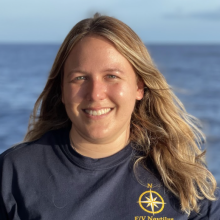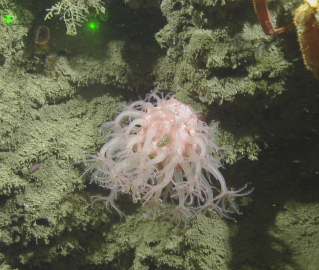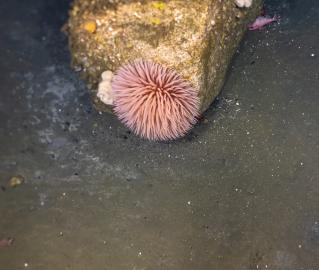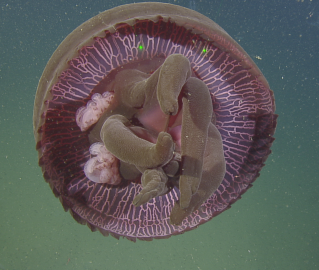
Meagan Putts
Tell us about your work/research. What kinds of things do you do?
I am a deep-sea researcher at the University of Hawai‘i (UH)Deep-sea Animal Research Center (DARC), the team of scientists specializing in imagery analysis that most notably assembled the NOAA Department of Ocean Exploration and Research benthic animal guide and completed the video analysis from the 2015-2017 NOAA CAPSTONE expeditions as well as the Nautilus expeditions from 2019 in American Samoa and 2018 within the Papahānaumokuākea Marine National Monument. I am also the data manager, outreach coordinator, and navigator for the UH’s ROV Lu‘ukai. In addition, I designed and maintain the Hawai‘i Undersea Research Laboratory (HURL) archive, UH Marine Center and DARC websites.
What sparked your initial interest in your career?
I knew I wanted to be a marine scientist since I first peered into a tide pool near Bar Harbor, Maine when I was 8 years old. The wild and fantastic world I found in those shallow depths filled my head with a desire for exploration and discovery that has driven me to dive deeper to learn more about the mysterious denizens of the seafloor.
Who influenced you or encouraged you the most?
My mom is and has always been my biggest supporter, encouraging me to stretch and follow my dreams even when they take me to far-off places in the Pacific Ocean. She was always there to support me even when I was told time and again growing up that I would “change my mind” about what I wanted to do for a career. She encouraged to keep my drive and motivation when others thought that my goals were “too big and hard” for me to accomplish. Without her, I would not be living my dreams like I am today.
What element of your work/study do you think is the most fascinating?
One of the main topics my research has been focused on is understanding the development and community structure of deep-sea coral and sponge communities. Using video collected by the HURL Pisces V submersible and NOAA’s ROV Deep Discoverer, I was able to examine in detail the coral communities established on lava flows off the leeward coast of Big Island of Hawaii. As deep-sea coral species grow at extremely slow rates, the lava flows provide a known maximum age for each community since new communities can begin to grow as soon as the lava cools. This allows for the examination of the community development process across longer time scales than would be normally possible within a human lifetime. It takes some communities 1000’s of years to grow to their full majesty!
What other jobs led you to your current career?
I have always been more interested in invertebrates than mammals, but just to give marine mammals a try, I volunteered at the Marine Mammal Pathobiology Lab during college. It was fascinating yet fragrant work, and I learned a lot about cause of stranding and/or death determination, sample collection, and record keeping. However, nothing could keep me from the invertebrate fan club. I found my love for animal identification and taxonomy when working at Water and Air Research, Inc., an environmental consultation company in Gainesville, Florida. I had been hired and started work as a technician there just weeks after completing my undergraduate degree. There I learned about the different methods and metrics used to sample and assess the health of Florida’s springs, streams, rivers and coastal areas. Though my favorite project was processing dredge samples from off the coast of Puerto Rico. Every sample was full of new taxa to identify and our team even found an undescribed species of polychaete!
What are your degrees and certifications?
Masters in Marine Science at Hawai‘i Pacific University, Honolulu, Hawai‘i
Bachelors of Science in Marine Science and Visual Arts at Eckerd College, St. Petersburg, Florida
What are your hobbies?
Some of my hobbies I love taking to sea with me include playing my handpan, reading and crochet. When at home I love spending my time outdoors hiking, surfing, paddle boarding, kayaking, sailing, diving or just enjoying the beach.
What advice would you give someone who wants to have a career like yours?
Never stop reading! If something catches your interest, read about it. If something in the reading you just did sounds interesting, read about that too. I was that girl with her nose in a book wandering the halls during passing periods and sneaking glimpses into worlds of worlds whenever there was a spare moment, now I help explore the deep sea.
The advice I wish that I had been given is, learn computer coding. It took becoming overly frustrated with doing monotonous tasks and being unsatisfied with the limited options of easy DIY web design programs for me to take the dive down the rabbit hole into learning how to better communicate with my computer and write in a language(s) it understands. It turns out that while this comes with its own frustrations, it is extremely rewarding and a great way to boost your career.
How did you get involved with the Ocean Exploration Trust?
I can never get enough of ocean exploration and first became involved with OET as part of the Scientist Ashore program. I had been, and still am, a frequent shoreside contributor for Okeanos Explorer expeditions, and also served as a science lead on two EX expeditions to the Musicians seamounts in the Pacific and Canyons and Seamounts of the Northeast and Canada in the Atlantic. I had always wanted to sail on the Nautilus, and was recommended to join the Hawai‘i-based expeditions by my college, Dr. John Smith, as I have a number of skills that would be beneficial to the expedition team including previous experience as a science lead, ROV navigator, and data manager.
With the smallest beam of light we discover the unexplored and unexpected.
Expeditions
Meagan participated in the following Ocean Exploration Trust expeditions:



